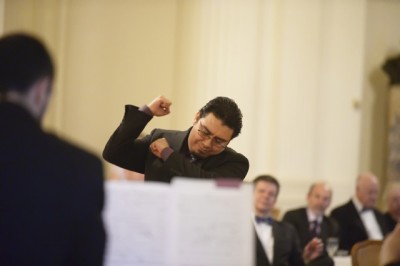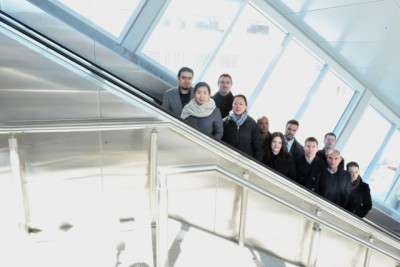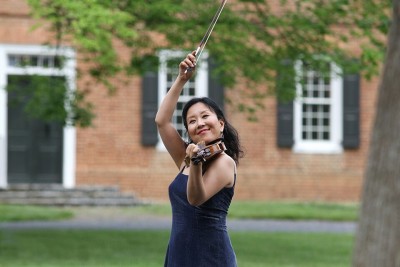Grace Cho and Alejandro Hernandez-Valdez were born and bred in cities some 7,286 miles apart with almost nothing in common except a passion for the piano. In Seoul, South Korea, Cho had a conventional musical education from age 6, culminating at Seoul National University. Hernandez-Valdez, the youngest of eight children, began playing at age 12 in his native Guadalajara, Mexico; a chance audience member arranged for his all-expenses paid education at the Shenandoah Conservatory in Winchester, Va.
The lives of the co-founders and co-directors of the New Orchestra of Washington (NOW) converged in 2001 at the Sarah and Ernest Butler School of Music at the University of Texas in Austin where both were working on graduate degrees in piano performance–she a master’s, he, a doctorate. Under the supervision of the same teacher, they met and began dating.
Known for musical genres including rock, folk, country, bluegrass and zydeco, Austin was not the ideal home base for the classical musicians. Already aware that the East Coast would be more hospitable, they met music professor Rita Sloan at the Aspen Music Festival, and accepted her invitation to study with her at the University of Maryland. Sloan had convinced them that the D.C. music scene was less crowded than New York City’s, and they would be less likely to burn out, recalled Cho, who subsequently earned a doctorate at Maryland.

The couple relocated in 2004 and quickly became immersed in D.C.’s classical music community, initially with choral groups, she working as assistant conductor at The Washington Chorus, and he as associate conductor and pianist at the Choral Arts Society of Washington and director of music as Westmoreland Congregational United Church of Christ. In addition to teaching, conducting and accompanying, the two gave highly praised four-hand performances in D.C. and Mexico.
Everything changed the summer of 2011, when Hernandez-Valdez and Cho drove cross-country—it took about seven days—to the month-long Bach Festival in Eugene, Ore. “Once we got past Ohio, the scenery was breathtaking,” said Cho, who noted that the drive time from one end of Korea to the other is four hours.
At the festival, a performance of a chamber orchestra adaptation of Gustav Mahler’s “Symphony No. 4” inspired the couple. On their return road trip, they brainstormed about the potential for creating “an ensemble that would focus on creative programming, dynamic performances, financial sustainability and a contemporary approach to audience engagement.”
Post-recession, they felt, would be the perfect time for a down-sized orchestra. There was no shortage of talent available, with “a lot of opera companies, orchestras and choruses struggling, even going bankrupt,” Cho said. “(And) we knew a lot of people; we had built a community of musicians in D.C.” A typical orchestra, she pointed out, composed of 80 to 100 highly trained, highly compensated musicians is very costly, and tickets sales do not come close to paying expenses. By reducing the ensemble’s size, the pair believed they had found a way for “orchestral and chamber music to survive and flourish in the 21st century.”

They envisioned an ensemble in which one person plays one part. “Instead of 30 violins, we have four or five; instead of a string section of 60 or more, we have 10 to 15. That way, everyone is a virtuoso, under the spotlight. The importance of each person’s contribution is elevated,” Cho explained, noting that in a traditional orchestra, players of lesser ability can “deplete the energy of a section.” Thus, she reasoned, the reduced size brings up the performance level. Another benefit, she said, is that the audience has a clear view of each performer.
In June 2012, NOW performed its pilot concert—with 14 players—featuring Copland’s “Appalachian Spring” at Westmoreland. “When the concert was over, we knew we had a chance,” Cho said. “The audience was teary-eyed. It was one of those magical moments in your life that you remember.”
NOW’s ever-growing diverse repertoire includes fresh interpretations of classic works as well as newly commissioned pieces, with “a focus on symphonic works rearranged” for smaller ensembles–such as the Mahler adaptation that sparked the idea for the group. With a roster of 30 to 50 highly-qualified musicians, the orchestra expands and contracts to accommodate the requirements of various repertoire and venue sizes.
To reduce overhead, ensemble members also take on administrative roles–including Cho who is the group’s executive director. “The idea of the socially awkward artist ended long ago,” Cho observed. “Today’s musicians are savvy, organized and active on social media.” She credits the Washington Chorus’ Dianne Peterson with having taught her a lot about arts administration.
NOW released its first CD in 2014, funded by a Kickstarter campaign that took in $23,000, the largest amount raised by an area arts organization, Cho said. A second CD, “is in the can,” Cho said, and will come out in 2017.

The tale of two cities theme recurred in the duo’s lives in the summer of 2015, when Hernandez-Valdez became artistic director of the choral ensemble Musica Viva and director of music at the Unitarian Church of All Souls in New York City. The couple and their 13-month-old son now live in two places, their house in Silver Spring and a high-rise apartment in Queens within easy commuting distance of Manhattan. While working in two cities offers “an amazing opportunity,” Cho said, “splitting the family” is not easy. Cho spends more time here, as NOW’s executive director and also serving Unitarian Universalist Congregation of Rockville’s director of music.
NOW’s fifth season will open with two pieces first premiered in Washington, D.C: Igor Stravinsky’s “Dumbarton Oaks” and Aaron Copland’s “Appalachian Spring.” The program also will feature Edouard Lalo’s “Symphonie Espagnole,” with soloist, violinist Akemi Takayama. Cho will play piano and Hernandez-Valdez will conduct. The concerts will begin at 8 p.m. Sept. 16 at LIVE, 10th and G, D.C., and at 7 p.m. Sept. 17 at Westmoreland UCC, 1 Westmoreland Circle NW, Bethesda. Tickets are $40, $15 for ages 12 to 18, and free for children. A pre-concert talk will begin one hour before each concert and a wine reception with the artists will follow the concert. For information, visit http://neworchestraofwashington.org.